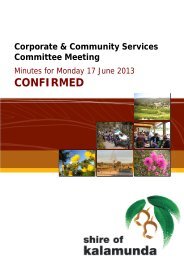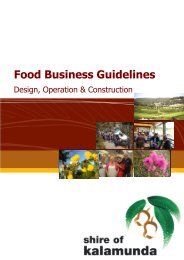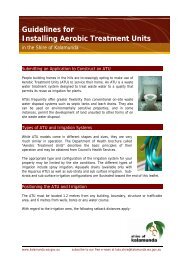Local Biodiversity Strategy: - Shire of Kalamunda
Local Biodiversity Strategy: - Shire of Kalamunda
Local Biodiversity Strategy: - Shire of Kalamunda
You also want an ePaper? Increase the reach of your titles
YUMPU automatically turns print PDFs into web optimized ePapers that Google loves.
Summary <strong>of</strong> General Comments Officer Comments Reference for<br />
Items Actioned<br />
Several targets refer to ‘significant or substantial populations’ <strong>of</strong><br />
Priority Species or Threatened and Specially Protected Species.<br />
Recommend the word ‘viable’ be used instead. The former words<br />
are open for interpretation. The aim should be to protect<br />
populations <strong>of</strong> flora and fauna that are viable in the long term.<br />
Definition <strong>of</strong> what is a viable population <strong>of</strong> a species can be<br />
better determined and more objective than relying on subjective<br />
judgements <strong>of</strong> what is considered significant or substantial.<br />
Comment noted. Considered in the development <strong>of</strong> the<br />
<strong>Local</strong> <strong>Biodiversity</strong> <strong>Strategy</strong>. The term viable is also difficult<br />
to quantify as what a viable population may be for long<br />
term retention <strong>of</strong> a particular species is not well known.<br />
The <strong>Local</strong> <strong>Biodiversity</strong> <strong>Strategy</strong> does not mention ‘Potentially<br />
Threatened Ecological Communities’ and significant flora and<br />
fauna species (other than rare and priority species).<br />
Significant species are recognised by the EPA as a conservation<br />
priority (EPA 2006). The list <strong>of</strong> significant species for the Perth<br />
Metropolitan Region is listed in Bush Forever Volume 2 (Govt. <strong>of</strong><br />
Western Australia 2000b).<br />
Box 6 on page 40, What is the definition <strong>of</strong> substantial in ‘retain<br />
and protect natural areas containing substantial populations <strong>of</strong><br />
…’?<br />
Priority one and two flora species should be ensured absolute<br />
protection, regardless <strong>of</strong> the size, if their loss should mean<br />
extinction <strong>of</strong> the species.<br />
Document amended to reflect comment. See Section 8<br />
<strong>Biodiversity</strong><br />
Feature Targets<br />
pages 33 – 48.<br />
Comment noted. Considered in the development <strong>of</strong> the<br />
<strong>Local</strong> <strong>Biodiversity</strong> <strong>Strategy</strong>. Although various State<br />
Government policies refer to priority species, Statutory<br />
protection would benefit from the introduction <strong>of</strong> a State<br />
<strong>Biodiversity</strong> Conservation Act.<br />
Comment noted. Considered in the development <strong>of</strong> the<br />
<strong>Local</strong> <strong>Biodiversity</strong> <strong>Strategy</strong>. The term substantial is also<br />
difficult to quantify as what a substantial population may<br />
be for long term retention <strong>of</strong> a species is variable and<br />
should be considered on a case by case basis.<br />
Comment noted. Priority flora have the same level <strong>of</strong><br />
protection as all endemic species under the Wildlife<br />
Conservation Act, 1950. The <strong>Shire</strong> looks forward to the<br />
introduction <strong>of</strong> the impending <strong>Biodiversity</strong> Conservation<br />
<strong>Local</strong> <strong>Biodiversity</strong> <strong>Strategy</strong> Page 115
















